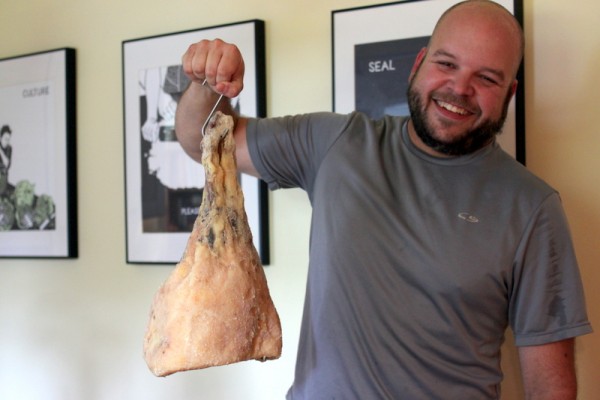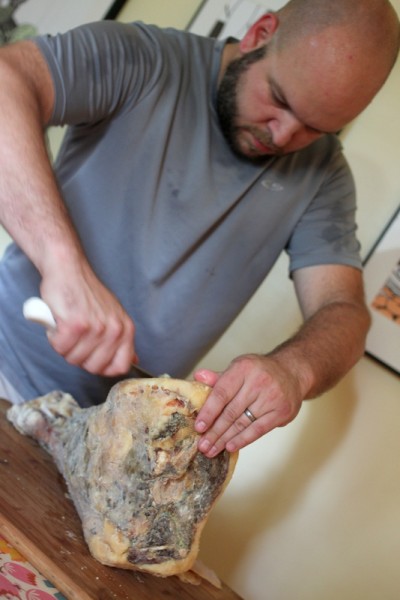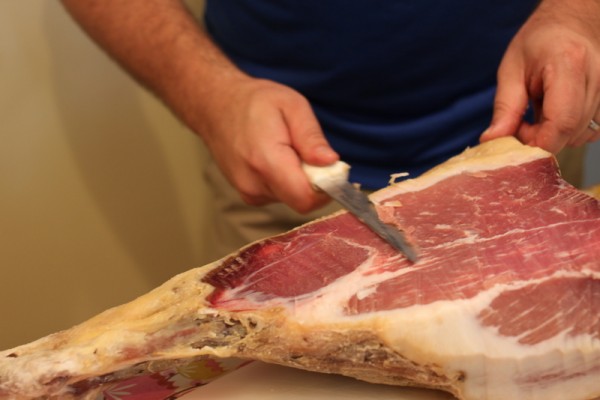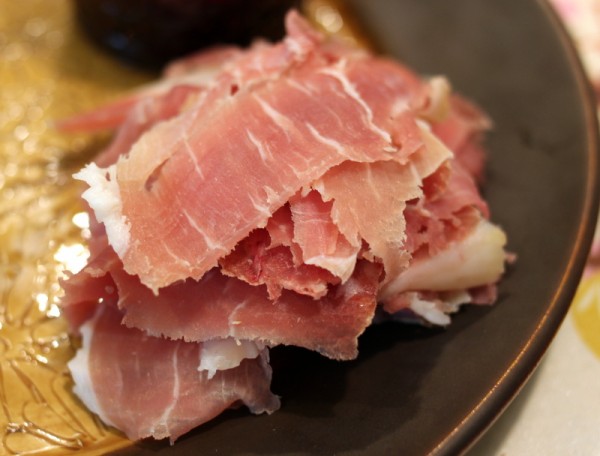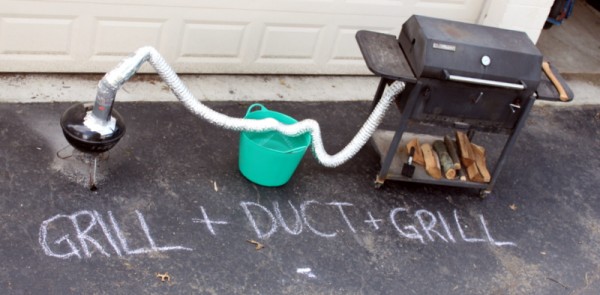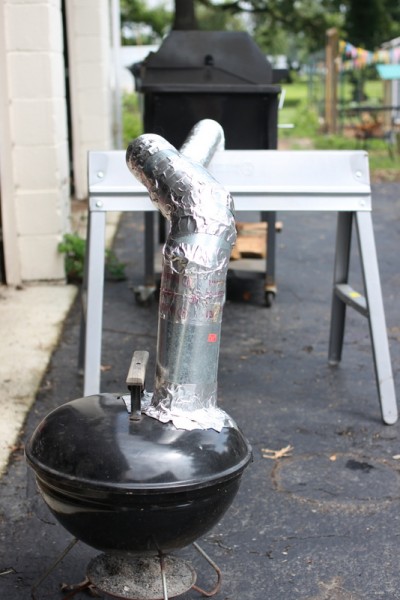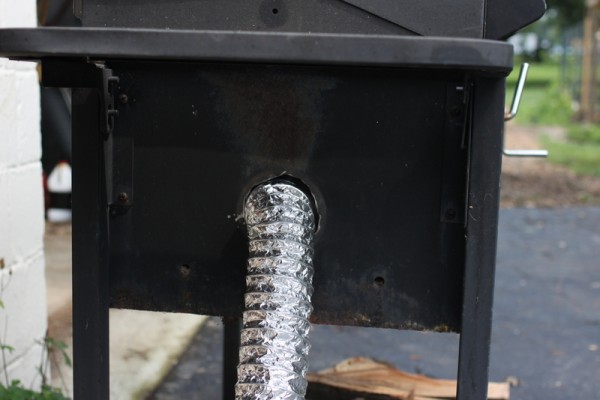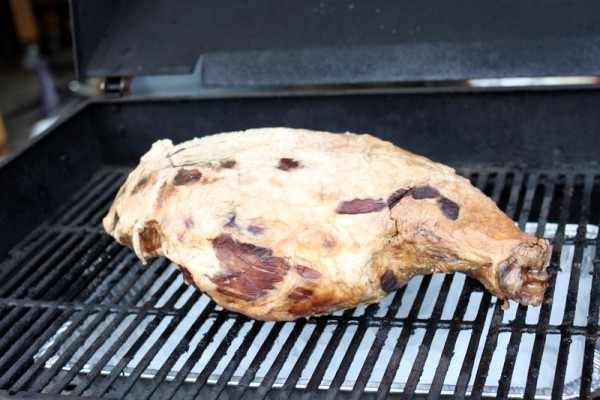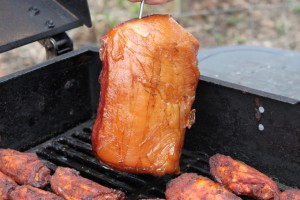Homemade Dry Cured Ham {Silent Sunday}
Homemade Low-Cost, High-Character Cold Smoker Contraption
Today I will reveal the second craziest homemade cold smoker ever created. It was born from a desire to cold smoke a molasses cured, home butchered ham without breaking the bank and inspired by the craziest homemade meat cooking devise, my father's Hillbilly Ham House.
Behold Alex's Cold Smoking Contraption.
To build this beauty, Alex started with a gifted excess mini Weber grill and removed the top vent. He arranged a length of round furnace pipe acquired for $3 at the Habitat ReStore into the hole, followed by a $5 length of flexible dryer vent. Connections were reinforced with aluminum duct tape, $5 a roll.
The dryer vent ran into the modified lower vent of our existing large charcoal grill. Alex used the angle grinder and many curse words to extend the hole enough for the pipe to fit in properly. The grill remains usable to cook off meat with charcoal.
Useage is simple: Build a small wood fire in the mini Weber. Put the meat on the big grill and monitor temperature. After 18 hours, you have ham!
The dryer vent was incapable of handling the smoke heat for the duration and melted through once. Alex cut off the effected part, reattached with tape, and went about the smoking. A more permanent solution would be durable flexible hosing or connecting pieces of furnace pipe.
Cold smoking is the act of surrounding a piece of food with smoke but little to no residual heat. The ideal cold smoking temperature for a ham is 60 degrees F. Given that the air temperature in summer is generally higher than 60, adjustments can be made. We kept a pan of ice in the base of the meat chamber to help keep cool and were able to average about 75 degrees F.
Alas, our basement is still a little too warm for dry curing, the next step in the ham Alex wished to make. We ended air drying early before mold set in and packaged the ham in slices and chunks for the future. Someday we'll learn that hams are not meant to be made in July.
What do you think of Alex's creation? DIY genius or a bunch of junk?
PS. For classier Weber modifications, head over to our friend Dave's site Webercam.com.
Sweetheart, Sweet Heart {Charcutepalooza}
My final Charcutepalooza post, on the topic of showing off, takes the form of two family stories.

Once upon a time in 13th century Europe, lived Devorguilla of Galloway. Devorguilla was a woman of substance (i.e. wealthy land owner) whose parents arranged her marriage to John de Baliol.
Read more of the Baliol family history on Tom Baillieul's website if you wish - it's pretty fascinating stuff! Tom, Alex's father, also painted and graciously allowed me to use the Devorguilla/John de Baliol crest on the right.
When John died in 1269, Devorguilla embalmed his heart and enshrined in a decorative ivory box to accompany her everywhere. Legend has it that Devorguilla had this heart seated at the opposite head of her dinner table and donated John's portion of the meal to the hungry.
History shows that Devorguilla likely coined the term 'sweetheart' through her dedication to John even after his death. In 1290, she was buried with John's heart at a Cistercian monastery she founded with the name 'Sweetheart Abbey'.
Consumption of the Sweet Heart
703 years after the death of Devorguilla, her descendant Alex Baillieul was born. Alex grew to be an adventurous traveler and cook proud of his Balliol heritage.
Alex's wife Rachel embarked on a year long charcuterie project in 2011, the culmination of which was to be a dish or meal that showed off four styles of meat curing. At the same time as the final Charcutepalooza project assignment, Rachel and Alex intended to attend a CMH Dinner Club with the theme 'show your roots'.
Rachel could think of no 'roots' story better than that of Devorguilla. She knew that she and Alex had to create an edible sweet heart.


Noticing very little fat (or inedible bits), the curing plan became clear: the heart would be cooked slowly in goose and bacon fat. A recipe on From Belly to Bacon confirmed that confit is an appropriate technique for this unusual cut of meat.
When tender, 12 hours after cooking, Alex cooled the heart in the fat. To serve it, he sliced the muscle into thin pieces and seared them in a hot pan. Rachel prepared a rosemary honey drizzle to garnish the sweet heart.
Rachel and Alex ultimately were unable to attend the CMH dinner club. Instead they served sweet heart, fermented Spanish-style chorizo, duck prosciutto, squirrel rilletes, homemade cornichons, and sour cherry preserves on a charcuterie platter for Thanksgiving with extended family, retelling the story of Devorguilla.
Adventurous diners were surprised at the luxurious heart. It was beefy and rich with melt-in-your-mouth texture. Lil declared it "better than hamburger". Devorguilla's namesake, the big hound Devie, heartily approved of the dish, complaining only that she did not get more pieces as treats.
Sweet heart, a dish honoring an ancient relative with the ancient art of charcuterie, was the perfect ending to a year of cured meat.
Final Relfections
I, Rachel, entered the Charcutepalooza challenge with a fair amount of meat curing experience. Any fears of raw meat, botulism, icky meat casings, and expensive investments had already been overcome at the beginning of 2011. Instead, I took on Charcutepalooza as a lens through which to explore food writing and expose more people to the dark secrets of the meat hanging in my basement.
I attempted to record each challenge in a unique way - I told fiction, humor and non-fiction stories, shared new and interpreted recipes, showed off charcuterie in pictures and video, and opined on marriage, meat sourcing, squirrel and vegetarianism. Some of these posts were quite a stretch for my skills and patience but I advanced to spread the love of cured meat.
There is a fabulous trip to France awaiting one of the Charcutepalooza participants. I do not envy Cathy and Kim who must judge the entries. Fortunately, I feel like a winner already because this challenge has strengthened my confidence as a writer and home cook. It even convinced my family that heart is a sweeeeeeet meat.
[print_this]
Sweet Heart (Beef Heart Confit with Rosemary Honey) Makes: 50+ appetizer servings Time: 12 hours cooking, 48 hours infusion for honey
1/2 cup local lightly-flavored honey 1 stalk fresh rosemary
1 beef heart (4-5 pounds of meat) salt 2-3 quarts of goose, pork, or duck lard (we used a mix of all three)
1. Fold rosemary stalk to fit into the bottom of a half pint jar. 2. Cover rosemary with honey. Put a lid on the jar and set aside at room temperature for 2 or more days, until infusion reaches your desired taste. 3. Salt beef heavily inside and outside of the heart cavity. Chop into large pieces as necessary to fit in an oven-safe pan or pot. 4. Liquefy lard by heating it on the stove top. 5. Pour fat over the heart until all parts of the meat are covered. 6. Place in a 200 degree oven for 12 hours until meat is tender. 7. Cool the heart while submerged in fat. Under refrigeration, the heart keeps indefinitely. 8. For service, remove heart from fat by reheating on the stove top and straining off the fat when it is liquefied. (Fat may be reserved for future use.) 9. Slice the heart into pieces 1/8 inch thick. 10. Heat a cast iron skillet over high heat. Quickly sear heart slices and place on a bed of arugula or other lettuce on a platter. Drizzle with rosemary honey.
[/print_this]
A Six Year Old Makes Lardo & Rat Creature Quiche {Charcutepalooza}
The eleventh Charcutepalooza challenge is curing. Alex and I have cured and dried many meats including saucisson sec, fermented chorizo, and coppa. I asked my daughter Lillian to complete this challenge with me. She's been around hanging meat for most of her life. Curing requires minimal skill and can be left for days at a time, perfect for the distractable mind of a six year old. Watch how Lil cures lardo:
While the lardo cured and dried, our family began reading Columbus-native Jeff Smith's iconic juvenile comic series Bone. One character in the book, an adversarial rat creature, is so mesmerized by quiche that he wants to cook the protagonist Bones into quiche, dreams about quiche, and even argues so adamantly about quiche that the Bones repeatedly escape capture. For the rest of the series, the Bones call the quiche-loving, negligent soldiers 'stupid, stupid rat creatures'.


Alas, our lardo-making daughter did not like the quiche. Alex and I, however, think the the stupid rat creatures were right on: quiche is a great way to enjoy cured meat.
[print_this]
Stupid Rat Creature Quiche Makes: 6 Time: 20 minutes preparation, 40-50 minutes baking
4 ounces lardo, diced, plus several slices for garnish if desired 5 eggs, beaten 3/4 cup whole milk 1/2 teaspoon salt 10 grinds fresh black pepper 1 cup shredded cheddar single pie crust (my recipe here)
1. Preheat oven to 350 degrees F. 2. Cook lardo in a skillet until lightly browned, drain fat. 3. In a mixing bowl, beat together eggs, milk, salt and pepper. 4. Line a 9-inch quiche or pie pan with crust. Tuck under edges and finish with a fork or fingers. 5. Scatter lardo and cheese on the bottom of the crust. 6. Pour egg mix over the top. 7. Bake in oven for 40-50 minutes or until top is browned. 8. Cut into six slices and serve.
[/print_this]
This post is a part of the year-long Charcutepalooza challenge. Read below for our other meat-curing adventures and reflections.
Modern Mistletoe: Meat, Marriage, & Duck Prosciutto Pizza Waste Not, Want Not Squirrel Rillettes English Pork Pie Photojournal Almost All-Ohio Mouselline How to Make Hot Dogs Like a Girl Mint Lamb Sausage Inspired by Jorgensen Farms Taco Truck Chorizo Sopito Red’s Canadian Bacon or Why I Had to Kill a Pig To Eat Meat Again The Story of the Rachel Salt Cure Old and New Cider Syrup Bacon
Added to Simple Lives Thursday.
Charcuterie Class {Birthday Giveaway}
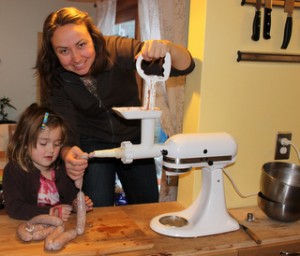 Ever wondered how to make bacon? Why nitrites/nitrates are sometimes used? Do you enjoy making meat jokes?
I will cover all this and more in my Charcuterie Class on October 18 at Wild Goose Creative, the last of my Preserving Series. Participants get to go home with tasting samples in their belly and a few fresh sausages to boot.
Ever wondered how to make bacon? Why nitrites/nitrates are sometimes used? Do you enjoy making meat jokes?
I will cover all this and more in my Charcuterie Class on October 18 at Wild Goose Creative, the last of my Preserving Series. Participants get to go home with tasting samples in their belly and a few fresh sausages to boot.
One lucky reader can win a place at the meaty table! Just leave a comment below with your favorite cured meat product.
Giveaway Details
The winner will receive free entry to the October 18 Preserving Class at Wild Goose Creative in Columbus, Ohio. Class time is 6:30-8:30 pm, value $35. Transportation to and from class is the responsibility of the winner.
Contest entries close at 12:01 AM EST on Friday, October 14, 2011. One winner will be selected with random.org. The winner will have 24 hours to respond to email notification to claim their entry. Only one comment per person please.
Disclosure: I am personally sponsoring this giveaway.
How To Make Hot Dogs Like A Girl {Charcutepalooza}
A story of a homesteader who meets her match in the common hot dog.
Go Girl!
Bone local beef with a sharp knife, grind it (standing on a stool because you're a short girl), and mix with salts. Feel so powerful that you go on to make cucumber relish.
The next day, you're ready to freeze, grind, freeze, puree, stuff, and smoke! There's a heat advisory, so shut the windows before you leave for morning errands and crank the A/C.
Hit a Snag
When you get home, it's hot inside. No noise from the air conditioner. It's ok, you are Super Homesteader!
Turn breakers on and off. Drive to the hardware store with fuses in hand, buy new ones, and replace them. Check the thermometer. Replace batteries here for good measure. Drink a beer.
Uh oh. It's still hot and you are out of your appliance repair ideas. Call husband, away on business, and complain. Call friend who was going to hot dog with you and cancel because it would be impossibly hard to keep meat cold in a house that is 85 degrees and rising. Call a repairman.
Cool Down
Repairman points out that the furnace fan isn't running because the idiot switch is disengaged. Turns out that the furnace fronts have been reversed the entire time you have lived at the house. Doh!
Drink a beer. Re-establish that you are a capable person by pickling and canning home grown cornichons.
Start Again
The next day, before even consuming coffee, start a fire in the charcoal chimney. Mix and freeze meat. Soak sheep casing. Grind and freeze again. Wash dishes. Stoke fire. Drink coffee.
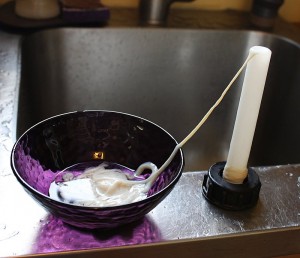 Push sheep casing onto the stuffer tube. Struggle. Think about how condoms began with sheep or hog intestines. Find a hole. Curse. Cut it off and start again.
Push sheep casing onto the stuffer tube. Struggle. Think about how condoms began with sheep or hog intestines. Find a hole. Curse. Cut it off and start again.
Struggle, finding more holes. Curse, cut, do over. Call husband and complain. Cry a little.
Finally get enough casing on the tube. Set aside.
Puree near-frozen meat in food processor. Curse at the damn safety measures that prevent you from using a spatula while the thing is running. Give in to Ruhlman's suggestion that you might need to split the batch. Puree and place in stuffer chamber. Stoke fire, add chips.
Almost There
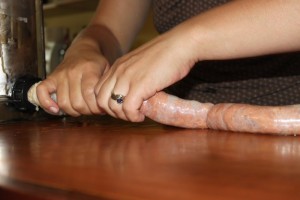 Smile. You've done this part before. Start turning the stuffer handle that pushes meat into the casing. Oh no! Meat squirts everywhere!
Smile. You've done this part before. Start turning the stuffer handle that pushes meat into the casing. Oh no! Meat squirts everywhere!
Tie off a new end, turn again. Puree is still squirting out of pinholes in the casing. Curse. Cry. Pour bourbon creme liquor in the coffee.
Push meat into the stuffing chamber and place in fridge to stay cool. Pull out some hog casings and start them soaking in water.
Start calculating how many hours this process has taken you. Stoke the fire. Call husband and ask how to keep fire going with limited amount of charcoal left.
Start Again Again
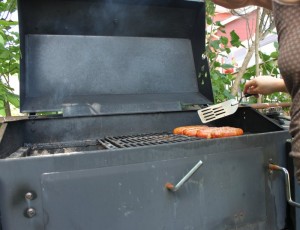 Rinse hog casings and string them onto stuffer tube. Pull out meat and begin stuffing again. Take questions from audience of your daughter and her four year old friend. Convince your daughter to open doors so you can lay hot dogs on the grill.
Rinse hog casings and string them onto stuffer tube. Pull out meat and begin stuffing again. Take questions from audience of your daughter and her four year old friend. Convince your daughter to open doors so you can lay hot dogs on the grill.
Wash dishes. Add wood chips to fire. Lend stuffer to friend so she can make brats and dogs tonight. Turn links. Stoke fire. Shoot some limoncello straight from the freezer.
Wait
Two hours later, internal temperature of dogs is barely 100. Sigh. Add more charcoal. Move dogs a little closer to the fire. Snap at the five year old who wants attention and then apologize. It's really the meat that's making you mad.
Recall that you don't really like hot dogs. Maybe that's why this whole process feels like a chore.
Eventually, give up on the smoker and bring the dogs inside. Wonder why a bunch of juice squirts out when the thermometer goes in. Bake them in the oven until the temperature reaches 150 degrees.
Reward?
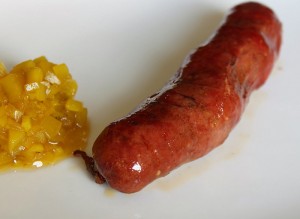 So fed up with the process that now cost you 1.5 days and hundreds of dishes, consider not even tasting the hot dogs. Remember that you are participating in this whole Charcutepalooza thing and you might as well at least take a picture. The dogs are wrinkly and misshapen but do taste ok with your cucumber relish.
So fed up with the process that now cost you 1.5 days and hundreds of dishes, consider not even tasting the hot dogs. Remember that you are participating in this whole Charcutepalooza thing and you might as well at least take a picture. The dogs are wrinkly and misshapen but do taste ok with your cucumber relish.
Vow to never make hot dogs again. A girl knows when something is not worth the trouble.
Much thanks to Lillian, the five year old, who tolerated my inattentiveness and took pictures of me working. She declares the hot dogs good enough to eat but wishes they were more greasy.
Red's Canadian Bacon Or Why I Had To Kill a Pig To Eat Meat Again
It was just over one year ago that my husband and I killed and butchered Red the pig. That single event informed my eating more than any other ever has. A Vegetarian Slaughters a Pig
At the time of the slaughter, I was a vegetarian, as I had been for a decade. I didn't eat meat for many reasons. Chief among them was that I didn't know how to assess the quality of the animal's life and I was uncomfortable with slaughter.
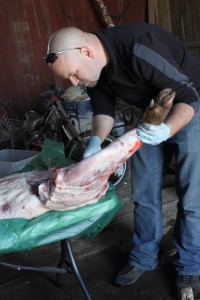 When I met Red, I could sense she was a happy animal. She had been given ample opportunity in her life to explore the land around her, eat like a pig, live with other creatures and roam with ample space.
When I met Red, I could sense she was a happy animal. She had been given ample opportunity in her life to explore the land around her, eat like a pig, live with other creatures and roam with ample space.
The moment of her death was stunning in how very not dramatic it was. I expected horror for some reason, and the end of her life was anything but. Alex carefully aimed a rifle, shot once, and she knocked over dead. It was as simple as the pulling of a dandelion weed or plucking of basil leaves.
As soon as Red died, we went to work butchering the meat. There was an overwhelming sense that what was killed at our hands must be used completely and well.
Beginning to Eat Meat
After the slaughter my attitude towards eating meat began to change. I started to realize that the designation I had made, that eating plants was ok and animals was not, was totally arbitrary.
When my husband grilled Red's ribs for his birthday dinner, I couldn't help but try them. I had seen with my own eyes the kindness of Red's life and her honorable death. I had participated in saving every part of her body and I wanted to participate in the consumption. I began eating meat that I knew had lived a good life.
Everything is a Sacrifice
"It had a nice life and then you killed it?!" is the accusation I have heard more than once from incredulous vegan friends. I hear the point: who are we humans to decide the end of a life?
In contemplating all the foods we cook, I realized that this choice happens with every meal that we eat, indeed every decision we make.
The tomatoes I grow and harvest are hard wired for reproduction. Whether they have feelings or not, their leaves and stems clearly gather water, nutrients, and sunlight for one goal: to make flower to fruit to seed to new plant.
If I pluck a ripe Julia Child heirloom tomato to chop and eat, am I not choosing to break that life cycle?
When I yank spinach plants from the garden bed after the weather has turned hot and they begin to bolt, I am intentionally depriving them of setting seeds and reproducing. I totally control the end of their nice life.
When I buy strawberries out of season shipped across the country, even if they are organic, there is no way they can possibly set seed and start new strawberry plants. On a bigger scale, the contaminants released by long-hauling crops thousands of miles deprive many species of clean air and may introduce reproduction-intercepting chemicals. We are negatively affecting our own personal and species health when we choose to consume well-traveled foods.
Realignment
I realized, in the examination of my feelings following the slaughter of Red, that my line in the sand was wrong. Killing a pig has no less value than killing a lettuce by eating the whole plant. They are both interruptions of the life cycle, choices I make to feed myself.
I suppose someone could argue that given the right conditions a fruit could re-seed itself whereas a dead animal will never make new life. Indeed volunteer tomatoes do always show up around my compost bin. But the staples of most non-animal diets - grains, leafy greens, tree fruits, root vegetables - are 'dead' in that they can no longer grow or reproduce, just like Red.
It took killing a pig to match my values to my diet. If all ingredients are dead, it is my belief that I must make sure their killing is humane and justified. I must use every part of the plants and animals I consume.
It is fitting that the last piece of Red left in the freezer, almost exactly a year after her death, was the loin, the subject of this month's Charcutepalooza Canadian bacon challenge.
As the smoke curled over the brined loin, I had time to reflect on Red's year-long journey. The act of knowing my food to the moment of its death transformed my thinking about what I eat and why. In the end I am left with gratitude that I have a chance to reflect and the opportunity to make choices about my food. Thank you, Red, and all edible plant and animal creatures, for feeding me.
Added to Fight Back Friday April 15 and Charcutepalooza April.

